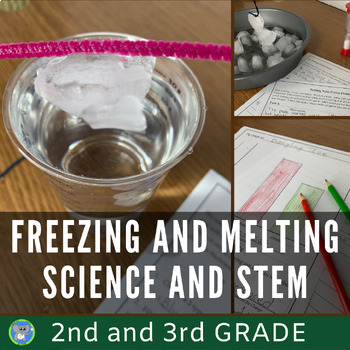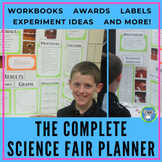Properties Of Water Science and STEM | Dangling Ice Experiment |Grade 2 3
- PDF
- Easel Activity
Also included in
- Everything you need to get your students on the right track for the science fair and award them at the end. Students will create original experiments at their level. The perfect guide for science fair coordinators from start to finish.You will need Microsoft PowerPoint, Google Slides, and MicrosofPrice $51.32Original Price $64.15Save $12.83
- Explore freezing and melting points by taking this classic experiment up a notch with an ice fishing STEM Challenge. This multi-grade bundle includes an experiment, further exploration activity, reading passages, and a STEM challenge. It is great for a science lab teacher or a homeschool with multipPrice $14.24Original Price $17.80Save $3.56
Description
Discover water's freezing point and salt's effects on ice with 2nd and 3rd grade. A complete unit with an experiment, reading passages, further exploration, and a STEM challenge. Uses inexpensive and easy-to-find supplies. Great for the winter and Christmas season.
Included in the Hands-On Investigation and Teacher Guide:
- K-2 NGSS Science and Engineering Practices Alignment
- 2nd Grade Structure and Properties of Matter NGSS Alignment
- 3-5 NGSS Science and Engineering Practices Alignment
- Background Information and Tips
- 3 Hands-on Activities
- 6-Page Dangling Ice Investigation Journal at the student’s level
- Further Exploration with different materials and a CER Prompt
- Ice Fishing Game STEM Challenge
- The Science of Salt and Ice Reading Passage
- How does Salt Make Ice Cream? Reading Passage
- Rubric and Answer Keys
- Link to a video tutorial with more tips.
- Terms of Use
Students will complete 3 activities. First, they follow the scientific method to test if the amount of salt will affect the ability of a piece of string to hold an ice cube. They will write a hypothesis, follow procedures, record observations and data, create a graph, and write a summary. Reading passages are included to help learn the science and vocabulary. The second activity explores further by testing other materials. The third activity is an engaging STEM challenge. Students will create an ice fishing game. By the end of this unit, the students should understand that melting requires heat, heat energy transfers, and the freezing point of water can be changed with salt.
Teachers will like its ease of use and simple supplies. They will enjoy the clear variables and alignment with the standards. Watching students' excitement as they lift the ice cube is always enjoyable. Teachers like having a complete unit with a final project. This is an excellent thermodynamics lesson. You can also integrate your teaching methods with note-taking, videos, tests, etc. Follow exactly, and you have 2 weeks of lessons done. If you are new to our science and STEM units, we recommend using a grade level lower and working your way up.
Supplies needed:
cups, ice cubes, salt, string, water, timer, variety of strings, pie pans or plates, and basic STEM building supplies for fishing poles and ponds (Supplies can be modified. Just test first.)
The length of time for this unit varies. If you only do the investigation, it can be completed in 60-90 minutes. If you add on the STEM and Further explanation activities, it can be a 5-day unit, maybe a couple of days more. As a science lab teacher, I make it a 5-6 week unit meeting once a week.
This investigation is part of a series. This is the 2nd/3rd grade version. Please click each grade level version below to see more details.
Freezing And Melting Ice Science And STEM | Winter Activity | Grade K 1
Freezing And Melting Points Ice Science And STEM | Winter Activity | Grade 4 5
Save 20% with the bundle.
Winter Science | Freezing And Melting Ice Science and STEM | A Grade K-5 Bundle
Great for the classroom, science fairs, STEM Fairs, science clubs, scout groups, center time, homeschoolers, and anyone wanting to discover salt on ice.
We prefer printing the journal, but digital versions can be helpful. The unit is a PDF but comes with a pre-created Easel by TPT overlay. We added text boxes and tips for completing it online. Click “Open in Easel” on the product page to get started.
You may also like:
Properties of Water: Surface Tension Grade K-5 Investigation Bundle
Properties of Matter: The Spinning Egg Test
Remember, leaving feedback earns you points toward FREE TPT purchases. We love hearing how the investigation went.
Also, follow us and be notified when new explorations are uploaded and deals.
Please contact us with any questions. We are here to help.
Yours in Science,
Kimberly Scott
Inspiring Lifelong Learnings through a Memorable Scientific Experience
All parts are copyrighted. Please see the terms of use in the download. Please use good lab practices. The seller is not responsible for the use or misuse of the activities.








